

List of valkyrie names. In Norse mythology, a valkyrie (from Old Norse valkyrja "chooser of the slain") is one of a host of female figures who decide who will die in battle.
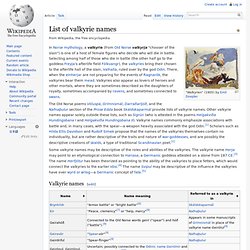
Selecting among half of those who die in battle (the other half go to the goddess Freyja's afterlife field Fólkvangr), the valkyries bring their chosen to the afterlife hall of the slain, Valhalla, ruled over by the god Odin. There, when the einherjar are not preparing for the events of Ragnarök, the valkyries bear them mead. Valkyries also appear as lovers of heroes and other mortals, where they are sometimes described as the daughters of royalty, sometimes accompanied by ravens, and sometimes connected to swans.
Valkyrie. In Norse mythology, a valkyrie (from Old Norse valkyrja "chooser of the slain") is one of a host of female figures who decide which soldiers die in battle and which live.
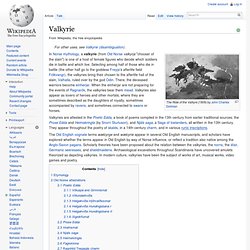
Aesop's Fables - Online Collection - Selected Fables - 656+ fables. Types of Sidhe Kin. The Sidhe or SHEE, Si, Sith, also pronounced SEE.
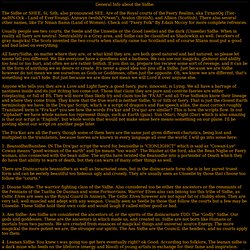
Are of the Royal courts of the Faery Realms, aka TirnanOg (Tier-na/HN-Ock - Land of Ever-Young), Annwyn (welsh/"Owen"), Avalon (British), and Albion (Scottish). There also several other names, like Tir Nman Bamn (Land of Women). Check out "Faery Folk" By Edain Mccoy for more complete refrences. The Grim Reaper. Lycanthropy. FAERY LORE. Lorelei. Lorelei rock on the Rhine Lorelei in 1900 Heine + Turner.
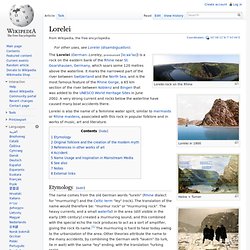
Leanan sídhe. In Celtic folklore, the Irish: leannán sí "Barrow-Lover" (Scottish Gaelic: leannan sìth; Manx: lhiannan shee; [lʲan̴̪-an ˈʃiː]) is a beautiful woman of the Aos Sí (people of the barrow or the fairy folk) who takes a human lover.
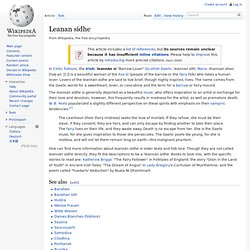
Lovers of the leannán sídhe are said to live brief, though highly inspired, lives. The name comes from the Gaelic words for a sweetheart, lover, or concubine and the term for a barrow or fairy-mound. The leannán sídhe is generally depicted as a beautiful muse, who offers inspiration to an artist in exchange for their love and devotion; however, this frequently results in madness for the artist, as well as premature death. W. B. Banshee. The banshee (/ˈbænʃiː/ BAN-shee), from Irish: bean sí [bʲæn ˈʃiː] ("woman of the sídhe" or "woman of the fairy mounds") is a female spirit in Irish mythology, usually seen as an omen of death and a messenger from the underworld.
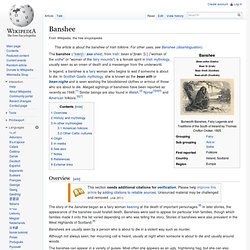
In legend, a banshee is a fairy woman who begins to wail if someone is about to die. In Scottish Gaelic mythology, she is known as the bean sìth or bean-nighe and is seen washing the bloodstained clothes or armour of those who are about to die. Alleged sightings of banshees have been reported as recently as 1948.[1] Similar beings are also found in Welsh,[2] Norse[3][4][5] and American folklore.[6][7] Overview[edit] Lilith. Lilith (Hebrew: לילית; lilit, or lilith) is a Hebrew name for a figure in Jewish mythology, developed earliest in the Babylonian Talmud, who is generally thought to be in part derived from a class of female demons Līlīṯu in Mesopotamian texts of Assyria and Babylonia.
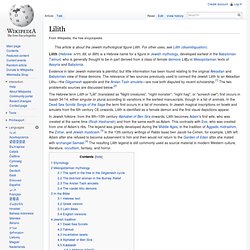
Evidence in later Jewish materials is plentiful, but little information has been found relating to the original Akkadian and Babylonian view of these demons. The relevance of two sources previously used to connect the Jewish Lilith to an Akkadian Lilitu—the Gilgamesh appendix and the Arslan Tash amulets—are now both disputed by recent scholarship.[1] The two problematic sources are discussed below.[2] The Hebrew term Lilith or "Lilit" (translated as "Night creatures", "night monster", "night hag", or "screech owl") first occurs in Isaiah 34:14, either singular or plural according to variations in the earliest manuscripts, though in a list of animals.
Etymology[edit] In Akkadian the terms lili and līlītu mean spirits. [edit] Sin-eater. The term sin-eater refers to a person who, through ritual means, would take on by means of food and drink the sins of a household, often because of a recent death, thus absolving the soul and allowing that person to rest in peace.
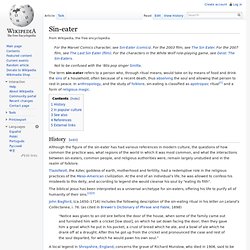
In anthropology, and the study of folklore, sin-eating is classified as apotropaic ritual[1] and a form of religious magic. History[edit] Manticore. The Fae Courts Monster Races Common Terms. The FeyThey say you can capture any Fae creature if you can drive an iron nail through their shadow.

Doing this is supposed to cause them great harm, but who cares, they’re just fairies, right? - Turen Ghek, Tomarr The Fey are an elusive lot. While many tales and legends exist, the facts seem to shift depending upon the particular fey. Local scholars have surmised this is because they are born of magic from the Wild Plane, but this has never been proven. …the single assumption which makes our existence viable – that somebody’s watching. - Tylwyth Teg People tend to think of fey as lovely creatures of almost unearthly beauty and grace, and are associated with the seasons of Spring and Summer.
Created when Father Fae took elven and human wives, they believe that they most closely resembling their maker, Father Fae. Daoine Sidhe The Daoine Sidhe (pronounced da-own-shee) are dark and sinister in appearance, and are associated with the seasons of Fall and Winter. The Unseelie Court, aka The Winter Court - The Academy. The Seelie Court, aka The Summer Court - The Academy. Those Fae associated with the Court of Summer tend to have coloration that corresponds to the colors of the summer season.
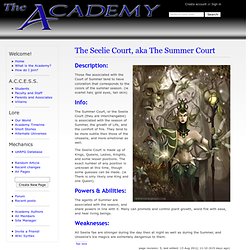
(ie scarlet hair, gold eyes, tan skin) The Summer Court, or the Seelie Court (they are interchangable) is associated with the season of Summer, the growth of Life, and the comfort of fire. They tend to be more subtle then those of the Unseelie, and more emotional as well. The Seelie Court is made up of Kings, Queens, Ladies, Knights, and some lesser positions. The exact number of any position is unknown at this time, though some guesses can be made. Wyldefae - The Academy. The Fae Bloodline - The Academy. Those of Fae Blood are the offspring of creatures from the Seelie or Unseelie Courts, or even the rare Wyldfae. There is no set history of when such pairings began, and through their deceitful natures any such story told would be questionable at best. What is known is that the Fae are older than humans, and most scholars assume they have been breeding with them for as long as they've existed.
I Need Help with fae history! Fairy godmother. In fairytale and legend[edit] Fairy witch trials of Sicily. In the historical folklore of Sicily, Donas de fuera (Spanish for "Ladies from the Outside"; Sicily was under Spanish rule at the time) were supernatural female beings comparable to the fairies of English folklore. In the 16th to mid-17th centuries, the donas de fuera also played a role in the witch trials in Sicily.
The Fairies of Sicily[edit] In historical Sicilian folklore, the donas de fuera would make contact with humans, mostly women, whom they took to Benevento ("the Brocken of Sicily"[citation needed]). The fairies were called donas de fuera, which was also a name for the women who associated with them. They were described as beauties dressed in white, red or black; they could be male or female, and their feet were the paws of cats, horses or of a peculiar "round" shape. Fairy.